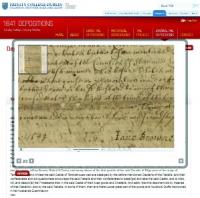The most controversial documents in Irish history?
Published in 1641 Rebellion, Early Modern History (1500–1700), Features, Issue 1 (Jan/Feb 2011), Volume 19
Prof. Jane Olhmeyer in Trinity’s Old Library, with a volume of Depositions in the background. (Trinity College, Dublin)
There have been attempts to publish the 1641 Depositions before, in the 1930s and 1960s, but these plans were abandoned thanks to the outbreaks of, respectively, World War II and the ‘Troubles’. After all, explains Professor Ohlmeyer, the Depositions were, and still are, extremely contentious. The fact that the testimonies were taken mainly from Protestant settlers means that they are ‘extraordinarily one-sided. They’re just one side of a story of murder [and] atrocity, and the fact that we’ve got one side of it is highly problematic, but the fact that we’ve got so much detail as well is also highly useful.’ Indeed, they are unique in early modern Europe. ‘And what is so interesting about them is what they tell us about ordinary life in early seventeenth-century Ireland, albeit from the perspective, largely, of the Protestant community, the Planter community. But there’s also indirect evidence on Gaelic and Catholic Ireland and the relationships experienced by the communities on the ground are captured.’ The one-sided nature of the Depositions is, she says, ‘very unfortunate. But I dont think it should stop us from looking very closely at this body of material’, even if the Depositions need to be handled with caution: ‘There are no quick fixes’. It is a necessary caveat, given just how charged some of their contents have proven to be. ‘What you hear is the pain and suffering of ordinary people . . . the trauma that they experienced, that comes across really, really strongly. And sometimes it’s eyewitness [testimony] but sometimes it’s hearsay but . . . it’s how they were articulating the madness that had descended on their worlds.’
The current project to publish the Depositions online had a lengthy gestation. Ohlmeyer, herself a graduate of Trinity College, returned there in 2003 from the University of Aberdeen and began, with colleagues, to explore the possibility of doing something with them. As she put it, ‘They’ve been in Trinity now since 1741, they’ve been used and abused over the centuries. Wouldn’t it be great to publish them in their entirety? It took us then three years to raise the money that we knew we would need; we knew at the outset it was going to be hugely expensive. What we didn’t realise was that it was going to cost us a million euro.’ The project became a major initiative, involving both Irish and British funding bodies, along with the universities of Aberdeen and Cambridge. Much of the day-to-day running of the project was the responsibility of her predecessor in Trinity, Aidan Clarke, for the simple reason that ‘nobody knows the Depositions as well as Aidan Clarke’. Other key figures were Brian Donovan of Eneclann, the TCD research and consultancy company, who was responsible for digitising the Depositions and overseeing the implementation of the project website (which was designed by KCO), and, of course, the transcribers themselves: Edda Frankot, Annaleigh Margey and Elaine Murphy. The funding was in place by 2007. ‘And then it took us three years to do the digitisation, get the transcriptions, and then it went online on 22 October 2010. It was finished within budget, over spec, and on time, so from that point of view, it was hugely successful.’
A screen-grab of Trinity’s 1641 Depositions website showing the entry for a Jane Brown, Co. Sligo. Note the fragment of the original manuscript (including her signature) and how indecipherable it is. In the background is the clearly typed ‘translation’.

A screen-grab of Trinity’s 1641 Depositions website showing the entry for a Jane Brown, Co. Sligo. Note the fragment of the original manuscript (including her signature) and how indecipherable it is. In the background is the clearly typed ‘translation’.
It also became obvious from an early stage that, given the scale and complexity of what was being attempted, publishing the Depositions would not be a straightforward process. ‘We wanted to do it to the highest possible standards’, but this was a time when ‘digitisation and online publication of resources was still really in its infancy’. Ohlmeyer attaches great importance to the technological aspects of the project, and is keen to engage the expertise of other companies—IBM is mentioned—in order to build upon it. The involvement of industry naturally raises questions about academic integrity, but Ohlmeyer does not accept that such links will result in cynical relationships. Given the increasing importance of technology to the humanities—a field in which Trinity is seeking to establish itself as a front-runner—Ohlmeyer is prepared to accept such relationships on pragmatic grounds, because, when it comes to a project of this nature, ‘the historians can’t do it on their own’. She is keen to stress the positives: industry will naturally have its own agenda, in commercial terms, but historians will also ‘gain hugely . . . otherwise we wouldn’t do it. And it’s about better research: how can technology help us, seventeenth-century historians, to interrogate and use the 1641 Depositions better.’ The significance of breaking ground in a relatively new field in the midst of a recession is not lost on Ohlmeyer. She sets out an extremely ambitious case for how new technologies can be used to make sense of the Depositions (and, by implication, other material) in the form of geographical, linguistic and social studies, to name but three. ‘We’re going to be able to relate an event to a person, to a place, and to chart that over time using technology . . . so the end result will give us a much fuller picture of the social, economic, religious, political and military history of seventeenth-century Ireland.’ The one-sided nature of the Depositions cannot be fully overcome, but it can be compensated for up to a point by bringing together the increasingly wide range of sources that are now available in electronic formats: ‘When you start to put all of this digital data together, it allows you to do things that we just haven’t done previously . . . information is one thing, but it’s how you get the knowledge out of it’.
The misuse of knowledge has traditionally been more to the fore in relation to the Depositions. Despite the role that 1641 played in sectarian polemics, surprisingly few people had ever looked at the Depositions in earnest prior to the late twentieth century. Surely one purpose of the project was to counteract the traditional sectarian accounts of 1641 by making the testimonies available? Very much so, says Ohlmeyer. Indeed, she is enthusiastic about using the Depositions to engage more broadly with public understandings of Irish history. ‘This sort of project can promote understanding, and in that sense is hugely important in terms of where we are as a political nation as we move forward in a very different world . . . it’s how you turn a negative into a positive. In terms of the project, we are approaching it in the spirit of promoting dialogue and scholarly debate in a very constructive way. I would be very disappointed if this became sectarianised in any form or fashion. Because that is not what this project is about. That would be a major disappointment if it happened.’ She speaks of very conscious attempts to promote outreach programmes based on the Depositions, for example in integrated schools in Northern Ireland.
But the publication of the Depositions in such an accessible format—the website is free to all—can, in Ohlmeyer’s view, assume a relevance far beyond Ireland. She speaks of plans for another potential project ‘that looks at massacre, atrocity and ethnic cleansing across history’, involving ‘historians from the classical world to the modern world, literary scholars, historical geographers, political scientists and political theorists, international lawyers, social psychologists and healthcare professionals who work with victims of trauma in the modern world’. Perhaps, she says, the Irish experience of ‘ethnic cleansing, massacre and atrocity’, as reflected in the Depositions, can be used ‘to speak to audiences in parts of the world today that are grappling with these issues. Whether we can do that or not, I don’t know, but that is certainly something that we are now actively thinking about doing.’ HI
The 1641 Depositions can be viewed online at http://1641.tcd.ie/. The related exhibition ‘Ireland in Turmoil’ continues in the Long Room, Trinity College, until 3 April 2011.
















